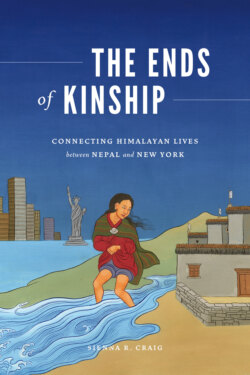Читать книгу The Ends of Kinship - Sienna R. Craig - Страница 15
На сайте Литреса книга снята с продажи.
FINDING THE WOMB DOOR WRITTEN ON THE FOREHEAD
ОглавлениеKarchung stoops over her handmade distillery: stainless-steel pots glued together with mud and ash to make a double boiler, a length of hose through which naked barley is transformed into alcohol. The operation is fueled by an open fire, crackling in the shade of a poplar tree. Karchung is fifty-something. This woman from the village of Drakmar has a narrow, weather-worn face. Her midriff is wrapped in striped woolen aprons over an old chuba. The style in which she wears her aprons, the weighty knot of turquoise around her neck, and the conch shell bracelet on her left wrist mark her as married.
Yangjin and I watch Karchung work, waiting for a break in the rhythm of her efforts to explain that we are doing a research project with women in Lo, and we would like to ask her about her family, about her experiences with pregnancy and birth. In Logé, we talk about the special ways that people from Tibet and the Himalaya have had their bodies changed by this place, over long stretches of history. We speak of blood and bone: about how lineage passes through bodies and how, from the perspective of Western science, they call this “gene.” We share that we want to learn more about the relationship between Himalayan women’s bodies and the circumstances of their family life.
Squatting beside the poplar, her spine against its trunk, Karchung takes a gulp of salt butter tea. “Life here is difficult for women and children, so I will talk with you about these things.”
We ask Karchung’s permission to write down the names of people in her household and make a list of her pregnancies and births—including miscarriages or children who died—and to draw her kinship chart. We also ask permission to collect a sample of her saliva, to measure her pulse, to take her temperature, and to find out how much iron and oxygen is in her blood. We explain that we do not need to take her blood to do this but that a small machine, put at the tip her finger, can reveal this information. “The machine will tell us some numbers,” Yangjin says. “We will write them down and tell you what they mean.” Yangjin goes on to say that this research will not benefit Karchung directly but that the information we learn may be helpful for future generations.
“What will you do with the saliva?” she asks.
“We will send it to America,” Yangjin answers. “There, the scientists will learn more about how Himalayan people live so well in our places. To learn what makes us different from other people who live by the ocean or down in the valleys.” She pulls out a small plastic vial, into which Karchung will be asked to spit.
Karchung laughs. “My son is in America. Now my saliva will go to America too! But this old ama stays here, making arak, doing the work.”
Over the next hour, we listen and take notes as Karchung shares details about her family and her household. She recounts her siblings, her husband, and his family. She recounts her eight pregnancies, including the three children who died between infancy and their toddler years. We ask her to explain what happened.
“There was a time, about ten years ago, when an old grandfather nöpa claimed many children. He took my two-year-old son and the child belonging to my cousin and his wife. Several others.”
“When you say, ‘took them,’ what do you mean?” I ask. “How did it happen?”
“He drowned them in the river,” Karchung continues.
“Why would he do that?”
“The grandfather nöpa was lonely and jealous because in [the neighboring village of] Ghiling they built a daycare center for the young children and got a beautiful Tibetan girl to take care of them while their parents worked. This grandfather nöpa thought he should also have children to keep him company. He took them through the element of water. We lost five or six young ones before he stopped.”
“How did you get him to stop taking children?”
“We did many rituals. This appeased him.” Karchung speaks with assuredness about a dynamic of causality that in other cultural contexts might be called a tragic accident: children drowning as they played unattended beside the river while their parents worked in fields. But for Karchung, the death of her child in this instance is linked to the destiny of other young children in ways that bespeak neither disease nor neglect but rather an act of ill will by an infamous being who belongs to this place.
Her story is also a claim to knowledge and what counts as an authoritative explanation for such a death. Others in the village affirm what Karchung has shared, noting that these drownings were the impetus for founding daycares throughout Lo.
Karchung explains that her second child succumbed to pox, like many others in this village in previous decades. We interpret this as measles. “In those days, we did not have vaccinations,” she says. Had there been such medicine available, maybe she would have six living children now.
The third child “died after a few days.” When we ask Karchung why this infant had died—not “What happened?” but “What was the reason for the death?”—she touches her brow, answering this question with a gesture. This happens countless times during that summer of 2012, as we interview more than eight hundred Mustang women about their reproductive lives. To touch the forehead is to acknowledge karma. Sometimes the course of a life is written here.
